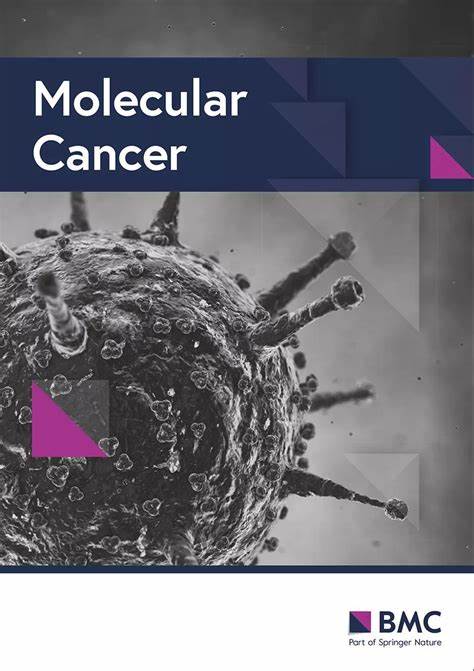Single-cell and spatial transcriptomic analyses revealing tumor microenvironment remodeling after neoadjuvant chemoimmunotherapy in non-small cell lung cancer
IF 27.7
1区 医学
Q1 BIOCHEMISTRY & MOLECULAR BIOLOGY
引用次数: 0
Abstract
Non-small cell lung cancer (NSCLC) represents the most common pathological type of lung cancer, and the combination of neoadjuvant immunotherapy with chemotherapy has emerged as the first-line treatment for NSCLC. Nevertheless, the efficacy of this therapeutic approach remains variable. The present study aims to examine the impact of chemoimmunotherapy in NSCLC patients, with a view to identifying key molecules, critical cell subpopulations, communication patterns and spatial distributions that potentially correlate with therapeutic sensitivity. A total of 16 lung cancer tissue samples were collected from a cohort of 12 NSCLC patients and subjected to single-cell RNA and spatial transcriptome sequencing. Our data demonstrated that the distribution of CD4 + Treg T cells and mCAFs indicated an immunosuppressive tumor microenvironment, while the accumulation of CD4 + Th17 T cells and iCAFs could act as a positive marker for the sensitivity to chemoimmunotherapy. Furthermore, a significant high level of SELENOP-macrophages was observed in tissues from positive responders, and a strong co-localization between SELENOP-macrophages and antigen-presenting cancer associated fibroblasts (CAFs) in the tumor boundaries was identified, indicating the cooperative roles of these two cell types in response to combined therapy. Moreover, SELENOP-macrophages were observed to be accumulated in tertiary lymphoid structures, which further suggested its critical role in recruiting lymphocytes. Furthermore, analysis of cell–cell communication, based on spatial transcriptomics, suggests that the interactions between SELENOP-macrophages, apCAFs, CD4 + and CD8 + T cells were significantly enhanced in responders. In addition, SELENOP-macrophages recruited CD4 + Naïve, Helper and CD8 + Naïve T cells through pathways such as the cholesterol, interleukin, chemokine and HLA when responding to combined therapy. The present study further unveils the dynamic spatial and transcriptional changes in the tumor microenvironment of non-small cell lung cancer in response to combination therapy.单细胞和空间转录组学分析揭示了非小细胞肺癌新辅助化疗免疫治疗后肿瘤微环境重塑
非小细胞肺癌(Non-small cell lung cancer, NSCLC)是最常见的肺癌病理类型,新辅助免疫治疗联合化疗已成为治疗NSCLC的一线方法。然而,这种治疗方法的疗效仍然是可变的。本研究旨在研究化疗免疫治疗对非小细胞肺癌患者的影响,以确定可能与治疗敏感性相关的关键分子、关键细胞亚群、通讯模式和空间分布。从12例非小细胞肺癌患者中共收集16例肺癌组织样本,进行单细胞RNA和空间转录组测序。我们的数据表明,CD4 + Treg T细胞和mCAFs的分布表明了免疫抑制的肿瘤微环境,而CD4 + Th17 T细胞和iCAFs的积累可以作为对化学免疫治疗敏感性的阳性标记。此外,在阳性应答者的组织中观察到显著高水平的selenop -巨噬细胞,并且在肿瘤边界发现了selenop -巨噬细胞和抗原呈递癌相关成纤维细胞(CAFs)之间的强共定位,表明这两种细胞类型在联合治疗反应中发挥协同作用。此外,硒代巨噬细胞在三级淋巴结构中积累,进一步表明其在募集淋巴细胞中的关键作用。此外,基于空间转录组学的细胞间通讯分析表明,应答者中selenop -巨噬细胞、apCAFs、CD4 +和CD8 + T细胞之间的相互作用显著增强。此外,selenop巨噬细胞在联合治疗时通过胆固醇、白细胞介素、趋化因子和HLA等途径募集CD4 + Naïve、Helper和CD8 + Naïve T细胞。本研究进一步揭示了联合治疗对非小细胞肺癌肿瘤微环境的动态空间和转录变化。
本文章由计算机程序翻译,如有差异,请以英文原文为准。
求助全文
约1分钟内获得全文
求助全文
来源期刊

Molecular Cancer
医学-生化与分子生物学
CiteScore
54.90
自引率
2.70%
发文量
224
审稿时长
2 months
期刊介绍:
Molecular Cancer is a platform that encourages the exchange of ideas and discoveries in the field of cancer research, particularly focusing on the molecular aspects. Our goal is to facilitate discussions and provide insights into various areas of cancer and related biomedical science. We welcome articles from basic, translational, and clinical research that contribute to the advancement of understanding, prevention, diagnosis, and treatment of cancer.
The scope of topics covered in Molecular Cancer is diverse and inclusive. These include, but are not limited to, cell and tumor biology, angiogenesis, utilizing animal models, understanding metastasis, exploring cancer antigens and the immune response, investigating cellular signaling and molecular biology, examining epidemiology, genetic and molecular profiling of cancer, identifying molecular targets, studying cancer stem cells, exploring DNA damage and repair mechanisms, analyzing cell cycle regulation, investigating apoptosis, exploring molecular virology, and evaluating vaccine and antibody-based cancer therapies.
Molecular Cancer serves as an important platform for sharing exciting discoveries in cancer-related research. It offers an unparalleled opportunity to communicate information to both specialists and the general public. The online presence of Molecular Cancer enables immediate publication of accepted articles and facilitates the presentation of large datasets and supplementary information. This ensures that new research is efficiently and rapidly disseminated to the scientific community.
 求助内容:
求助内容: 应助结果提醒方式:
应助结果提醒方式:


